الثلاثاء، 14 يونيو 2011
Mosaic Map – St. George’s Church – Madaba, Jordan
6th Century Mosaic Map – St. George’s Church – Madaba, Jordan
Madaba is best known for its superb, historically significant Byzantine era mosaics. Madaba’s most famous site is the Mosaic map in the 19th century Greek Orthodox St George’s Church. Unearthed 1864, the mosaic was once a clear map with 157 captions (in Greek) of all major biblical sites from Lebanon to Egypt. The mosaic was constructed AD 560 & once contained more than 2 million pieces, only 1/3 of the whole now survives.
6th century Madaba Map found during construction in 1898 of St George’s church, originally uploaded by anilegna.
Madaba, مادبا, is a capital city of Madaba Governorate of Jordan, which has a population of about 60.000. Madaba is the fifth most populous town in Jordan. It is best known for its Byzantine and Umayyad mosaics, especially a large Byzantine-era mosaic map of Palestine and the Nile delta. Madaba is located 30 miles south-west of the capital Amman.
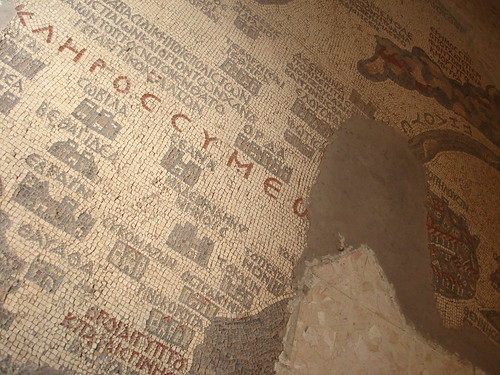
including rivers, valleys, the dead sea & its neighbouring hills & towns… on Flickr – Photo Sharing!
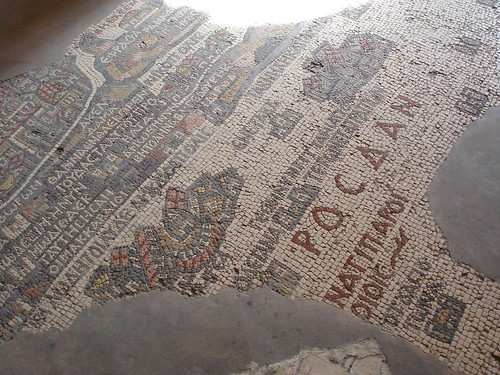
The Madaba Map is the oldest extant map of the Holy Land and is dated to the middle of the 6th century AD. It was discovered late in the 19th century, during an excavation and reconstruction of a mosaic floor in St George’s Church in Madaba, Jordan. The mosaic is a detailed map of Jerusalem as it appeared at the height of the Byzantine period. The map depicts some famous Old City structures such as the Damascus Gate, St. Steven’s Gate, the Golden Gate, the gate leading to Mount Zion, the Citadel (Tower of David), the Church of the Holy Sepulchre, and the Cardo Maximus.
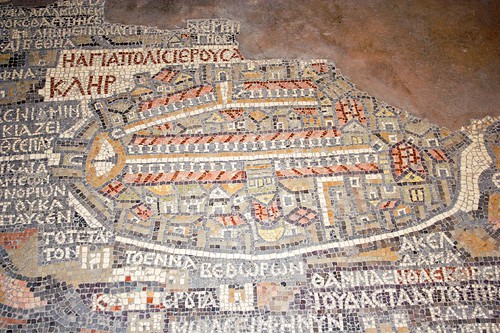
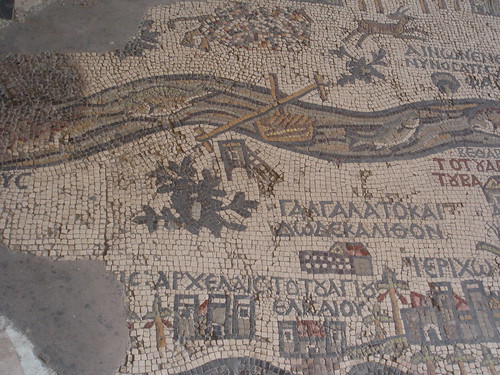
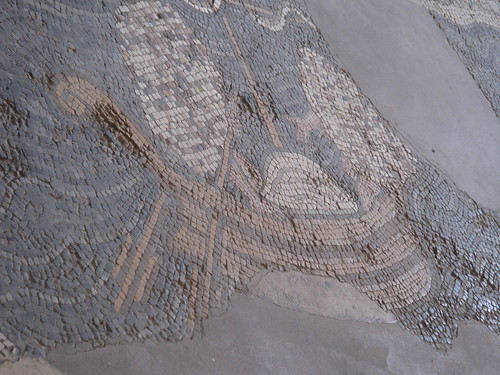
The first mosaics were discovered, purely by chance, during the building of the new permanent dwellings using squared-up stones from the old monuments. The new inhabitants of Madaba, made conscious of the importance of the mosaics by their priests, made sure that they took care of and preserved all the mosaics that came to light.
The mosaic Map of Madaba was discovered in 1896; the findings were published a year later. This discovery drew the city to the attention of scholars worldwide. It also positively influenced the inhabitants who shared the contagious passion of F. Giuseppe Manfredi to whose efforts we owe the discovery of most of the mosaics in the city. Madaba became the “City of Mosaics” in Jordan.
The northern part of the city turned out to be the area containing the greatest concentration of mosaic monuments. During the Byzantine-Umayyad period, this northern area, crossed by a colonnaded Roman road, saw the building of the Church of the Map, the Hippolytus Mansion, the Church of the Virgin Mary, the Church of Prophet Elijah with its crypt, the Church of the Holy Martyrs (Al-Khadir), the Burnt Palace and the Church of the Sunna’ family.
The Madaba Mosaic Map is an index map of the region, dating from the sixth century CE, preserved in the floor of the Greek Orthodox Basilica of Saint George. With two million pieces of colored stone, the map depicts hills and valleys, villages and towns in Palestine and the Nile Delta. The mosaic contains the earliest extant representation of Byzantine Jerusalem, labeled the “Holy City.” The map provides important details as to its 6th century landmarks, with the cardo, or central colonnaded street and the Holy Sepulchre clear visible. This map is one key in developing scholarly knowledge about the physical layout of Jerusalem after its destruction and rebuilding in AD 70.
Other mosaic masterpieces found in the church of the Virgin and the Apostles and the Archaeological Museum, depict a profusion of flowers and plants, birds and fish, animals and exotic beasts, as well as scenes from mythology and everyday pursuits of hunting, fishing and farming. Hundred of other mosaics from the 5th through the 7th centuries are scattered throughout Madaba
الأحد، 12 يونيو 2011
Madaba The Church of the Map
The Church of the MapThe Madaba Mosaic Map |
 The Madaba Mosaic Map still serves today as floor of the The Madaba Mosaic Map still serves today as floor of theGreek Orthodox parish church of St. George. The church, located to the northwest of the city center, was built in fact in 1896 A.D. over the remains of a Byzantine church, whose dating is probably to be set at the end of 6th or at the beginning of 7th century A.D. The church was divided into a nave and three aisles by two rows of columns, an arrangement that corresponds only partially with the present one. The mosaic panel enclosing the Map was originally some 15.60 by 6 m, that is 94 square meters, of which 25 are preserved, corresponding only to about a quarter of the total. The map covers the entire area from the south wall to the north wall of the church leaving only a little space for a frame, of which no remain has been recovered.
|
Madaba : The Kings' Highway
 Don't confuse this with the "Desert Highway" which is the main north-south highway nowadays in Jordan. The Kings' Highway is a very spectacular route which was the original north-south road from Biblical times until recently; today it is largely unused by through traffic which takes the Desert Highway. The Kings' Highway is neither cost nor time friendly for traffic, and unsurprisingly, there is no public transport that runs for all of its length; even the half dozen successive local buses that cover it now have a gap at Wadi Mujib. There have been many improvements to it over the last few years, and although it remains a twisting mountainous road, the surface is better and it is a little bit wider.
Don't confuse this with the "Desert Highway" which is the main north-south highway nowadays in Jordan. The Kings' Highway is a very spectacular route which was the original north-south road from Biblical times until recently; today it is largely unused by through traffic which takes the Desert Highway. The Kings' Highway is neither cost nor time friendly for traffic, and unsurprisingly, there is no public transport that runs for all of its length; even the half dozen successive local buses that cover it now have a gap at Wadi Mujib. There have been many improvements to it over the last few years, and although it remains a twisting mountainous road, the surface is better and it is a little bit wider.If you want to drive it, and it is well worth the effort, then you must use arental car or the bus that runs fairly regularly in season from Madaba(qv). Hitching is also a possibility, but you should be prepared to ride in several cars. If you do drive it, allow a whole day, especially if you stop to visit the various sites on the way : Hamamet Ma'in, the castle at Kerak, Wadi Mujib and Wadi Hasa and Dana. This is quite a difficult drive; if you cannot share the driving, try to schedule a less arduous day afterwards. Note that in bad weather, high winds, rain or snow, the Kings' Highway becomes dangerous, and is usually closed.
Many of the canyons of the Kings' Highway can be visited by canyoning enthusiasts - see the web page on "Canyoning in Jordan". In particular Wadi Mujib is one of theNature Reserves of Jordan with a highly organised (and popular) trekking programme.
The top entrance to the Nature Reserve of Wadi Mujib lies just off the Kings' Highway at Faq'a. Turn to the right (west) after Ariha, that is after you have passed the canyon shown above, at a village called Al Qasr. In theory you are about 70lkms from Madaba at this point and perhaps 10/12kms from Kerak. The other entrance to the Reserve is on the Dead Sea Highway.
There are some more photos of Wadi Mujib on the Photo Gallery pages.The Madaba mosaic map: With introduction and commentary
Khirbet al Mukhayat
Khirbet al Mukhayat is roughly between Madaba and Mount Nebo on a side road; it was originally the village near to the large Byzantine monastery of which the present Mount Nebo church is part of the basilica. The church is shown on the map as "Siyagha". If you are coming from Madaba you should turn to the left at al Faisaliya (named after Sheikh Faisal bin Jazi).
It is a tiny place nowadays, not even to be called a hamlet, and the road at the end is very rough and exposed which discourages any tourist coaches.It turns into a track before it arrives at the top of the hill at site of the"Martyrs' Church" of Saints Lot and Procupius where there are a couple of beautiful mosaics. In the valley below there are the remains of several other churches. The late, much regretted Father Picirillo had plans for their restoration; I am afraid this is not likely to happen any time soon now.
The remains of the chapel might be locked: the guardian lives in a small house alongside and will probably arrive in a hurry when he hears a car. If not, it is perfectly correct to knock and ask if you can visit.
One of the mosaics was placed above the other one which was completely covered and unknown until the newer one was removed for restoring. The figures on the older mosaic have thus escaped the iconoclasts. These mosaics are very attractive.
Here you have the four best known mosaics from Khirbet al Mukhayat : On the left the one from the Church of Saint Lot and St Procupius, beside it the one from Baptistry; the two on the right are from the Church of Preacher John. You will see that first three are of generally similar styles. The later one from the Church of Preacher John is quite different.
People looking for something out of the way, can't do better than to spend half an hour at this site. It is seldom visited by tourists and gives you an idea of the landscape south of Madaba stretching to the canyon country and to Wadi Mujib. It is stark and beautiful, and usually very windy! People who know France might be reminded of the Caussse country there.
The Mosaic Map of Madaba An Introductory Guide (Palestina Antiqua)
The Mosaic Map of Madaba An Introductory Guide (Palestina Antiqua)
الاشتراك في:
الرسائل (Atom)




















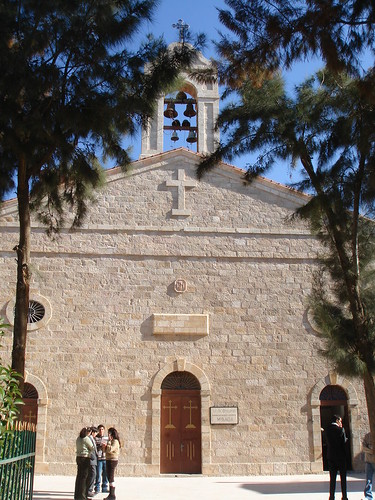
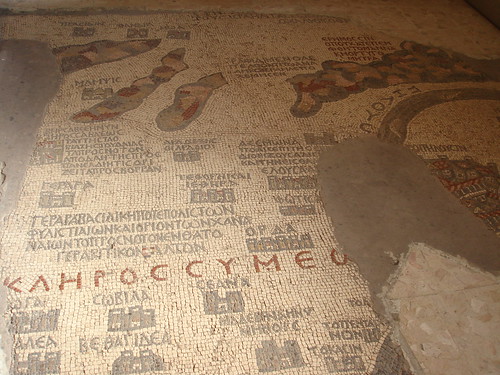





 Topographic extent, as well as iconographic parallels suggest that this had to be the town of Madaba whit all the details of its streets, churches and shrines. Unfortunately this part of the mosaic is not preserved, but this very idea may help us to understand the pride of the people of ancient Madaba, in seeing their town as part of the Land originally promised to the Jewish people and now belonging, by the grace of God, to the Christians, as truly legitimate heirs. Moreover, in the same Land, great events of salvation beneficial to humankind, were accomplished in the person of Jesus Christ, as related in the New Testament. All of this may still not be enough to give sense to every detail of the map.
Topographic extent, as well as iconographic parallels suggest that this had to be the town of Madaba whit all the details of its streets, churches and shrines. Unfortunately this part of the mosaic is not preserved, but this very idea may help us to understand the pride of the people of ancient Madaba, in seeing their town as part of the Land originally promised to the Jewish people and now belonging, by the grace of God, to the Christians, as truly legitimate heirs. Moreover, in the same Land, great events of salvation beneficial to humankind, were accomplished in the person of Jesus Christ, as related in the New Testament. All of this may still not be enough to give sense to every detail of the map.









